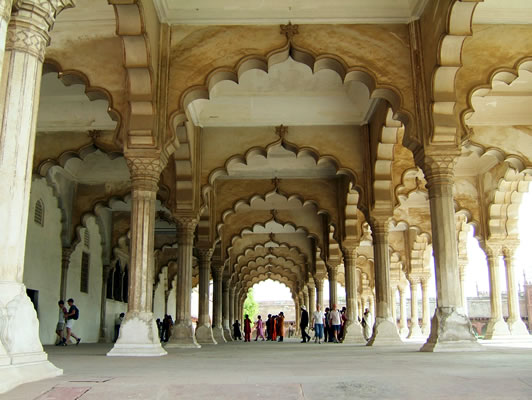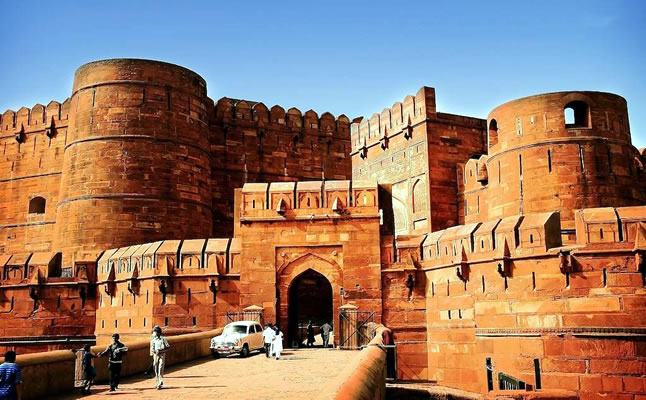Ram Bagh
(1526-30; 1615-19 A.D.)
Hindi Version | View Gallery |
|
[Not a valid template]Now known as Ram Bagh. This Garden was originally founded by Babur, the Founder of the Mughal Dynasty in India. He laid it out, in 1526, on the persian Terraced and Char Bagh (Four Quartered) Plan. He had seen such gardens at Samarqand. At Kabul, he founded several similar gardens as Bagh-E-Vafa, Bagh-E-Kalan, Bagh-E-Banafsha, Bagh-E-Padshahi and Bagh- E-Chinar. In descending terraces with a hill-side spring, water softly rippling from one terrace to the other in a series of waterfalls. Though no hill-side or a natural spring was available here. This garden was also made in three descending terraces. Water was drawn from the river Jamuna by a series of water-wheels and it flowed into a network of canals, cascades and tanks descending from one terrace to the other. Each cascade has stairs on both sides and ends in a pond, all built of red stone. [Not a valid template]Large platforms, pathways, tree-avenues, flower arterres and chhatris were provided at regular intervals so that the garden presented almost an ethereal atmosphere. Thus did Babur, the “Prince of Gardens”, fulfill his Ideal of a Garden (Bostan). He was much odoured by the heat, hot winds (Loo) and dust of Agra and as a protection against these, he also built a “Cold-Bath” in the basement of the uppermost terrace, on the river-side. Even in summer, it was “So Chilly That One is Almost Cold”, as he recorded in his memoirs. This garden was renovated by his great grandson Jahangir between 1615 and 1619. While the lower terraces, with their architectural waterchannels, cascades and tanks, and pathways, and the respective four-quartered gardens, were retained in their original form, two beautiful suites were built on the northern and southern sides of the open court on the uppermost (Main) terrace, overlooking the river. Each suite is composed of dalans and rooms which were decorated with figurative paintings, typical of Jahangir’s age. Swan brackets are used to support the court-side chhajjas. A large stone masonry tank, with fountains as inlets, is there in the middle of this court. It has an island platform (Mah-Tab), which is connected to the eastern side by a stone bridge. [Not a valid template]Water from the tank flowed down to the second terrace and to the third terrace through series of canals and cascades. The river bank with cool and fresh breezes, dense greenery of trees and cool shades; and running water through canals and cascades made it an extremely pleasant, lovely and romantic resort for relaxing in the hot climate of Agra and Jahangir was very fond of this pleasure-garden. He stayed here with the ladies frequently, as his memoirs record. He renamed it “Bagh-E-Nur Afshan”. It was included in Nurjahan’s Jagir (Estate). Her Riverine Sarai (Inn) was just attached to it on the northern side, where her officers collected duties on goods transported by the river. It was also greatly liked by the British who repaired and converted it into a Full-Holiday-Resort during the East India Company’s Rule (1803- 1857). The garden soon became famous as “Ram Bagh”, either from “Aram” (Rest) or Sanskrit “Aram” (Garden). [Not a valid template]Such exotic fruit trees as Shah-Alu, Zard-Alu, Shaft-Alu, Aluchah, Kokachah, Anjir, Nashpati, Saib, Badam, Bih, Tut (Shah-Tut), Baidana (Anar), Naranj, Khajur and Kolah were planted in this garden, alongwith such indigenous fruit and flower trees as Aam, Aonla, Amrud, Amaltas, Bel, Bijaura, Chakotara, Chironji, Gular Imli, Jamun, Kachnar, Karaunda, Kaseru, Kathal, Kait, Kamrakh, Khirni, Lakhaut, Lisaura, Maulsari, Sal, Saimal, Sharifa, Shisham and Tal, and such ornamental trees as Saron, Chenar and Nihal. It was, in fact, a vast fruit-garden and its fruits soon became famous all over northern India. While Babur’s preference was for large trees, Jahangir’s emphasis was on fragrant flower-plants. Tree-avenues and Flowerparterres were accordingly maintained from Babur to Jahangir. [Not a valid template]This garden is the ancestor of Mughal gardens in India. It was here for the first time that the Terraced and Four-Quartered Garden-Plan was introduced, and architectural water-devices, canals, cascades and tanks were inseparably associated with garden, and it was no longer an orchard alone. Babur’s innovation was followed by his descendants for more than two centuries, and it was also popularly adopted by their vassal states, and soon became a national style of gardening. |




